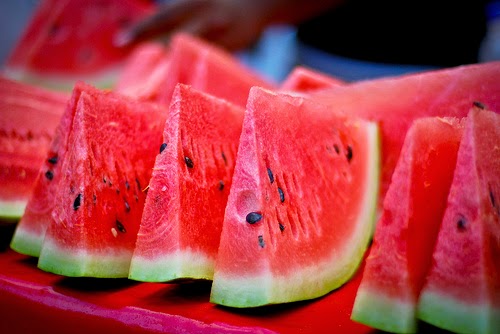Summer is well and truly under way and while it's my favorite time for looking good - less rain to mess up my hair and more excuses for pedicures - all that sun and heat means paying a little bit more attention to feeling good as well. The human body is more than two-thirds water and keeping yourself juiced up goes a long way to making sure
joints, eyes, brain, skin have the fluids they need while aiding digestion and keeping the skin healthy this season.
On an average day, the average woman needs about
2.2liters and the average man needs about 3 liters of water from foods and drinks to stay hydrated. As the heat increases, you are more likely to lose these fluids and natural salts through perspiration so it's important replenish yourself throughtout the day. Lots of sports drinks claim to be able to do the job but you can avoid the additives and see real results with some of these deliciously natural sources of hydrating nutrients.
Coconut Water
Coconut water seems to be everywhere at the moment and with
good reason. Unlike traditional sports drinks, leading brands contain no dyes, fat, cholesterol or added sugars but DO provide a natural source of 5 essential electrolytes - potassium, sodium, calcium, magensium and phosphorus - for rejuvenating after even the most hardcore workouts. Drinking the juice of young green coconuts has been standard practice throughout the tropics forever, but you don't have to go on vacation to get this nutrient rich tipple anymore.
Cucumber Spa Water
I love this one because it tastes fantastic, looks beautiful and cost pennies! Cucumbers on their own are not only full of water but also
potassium, vitamins K and C, respectively good for your cells, bones and the immune system. Sliced and soaked in a bottle or jug of water, they give you get all of these benefits plus a refreshingly cool taste with almost no trouble at all. Mix it up with a some lemon or fresh mint to make it a spa day any day.
Lemon Water
Drinking water with lemon is another beautifully
simple solution for anyone who likes eating out or going out. When you order your water with ice and slice, your adding calcium, Vitamin C and giving yourself a
detoxifying boost. Lemon naturally helps the liver to break down the external toxins from smog, chemicals and air conditioning that become much more relevant as the temperatures increase. As it's generally free and easily accessible, there's almost no reason not to hit it.
Watermelon
Growing up, I thought that you just ate watermelon in the summer time because it was delicious. While this is absolutely true, turns out that this perfectly pink treat has been found to be a natural source of
electrolytes like potassium, magnesium and phosphorus which help you to better dissolve all the water -
92% of the fruit - in the melon. All this plus it's fat free and contains lycopene, an antioxidant which has been shown to protect skin from the suns UV rays, making it the perfect summer snack.
Tomatoes
A fresh tomato right off the vine is like a mouthful of sunshine and at almost 95% water, they are a great source of fluids on a warm day. Like watermelon they provide a healthy dose of lycopene with every bite, as well as
antioxidants like Vitamin A and C. An extremely versatile ingredient, they are easy to add to salads, munch in salsa or eat as a stand alone snack.
Strawberries
This time of year strawberries are juicy, plentiful and full of goodness. Each little fruit is 91% water and just 8 strawberries can provide
more vitamin C than an orange. High in manganese, potassium and fiber, they make a fantastic summer treat that is easy to share, or not!
Celery
A single stalk of celery is made up of 96% water but also contains natural healthy salts and lots of fiber. All of these things help to keep digestion on track during challenging warmer weather. Great for juicing or eating raw, celery is also unique in that
it maintains up to 99% of its nutrients when steamed.
Water
And finally regular everyday water. If you're feeling thirsty, this is your body telling you that you need more to
drink more water, so respond accordingly. If you're taking it easy then drinking water should provide everything you need. But if you're working up a sweat, then your body will start to using up its electrolytes after about an hour and may need something with a higher nutrients mix. As the mercury rises it's useful to keep a reusable bottle to hand so that you can quench your thirst whenever and wherever you need.
As seen in
Clutch Magazine




















